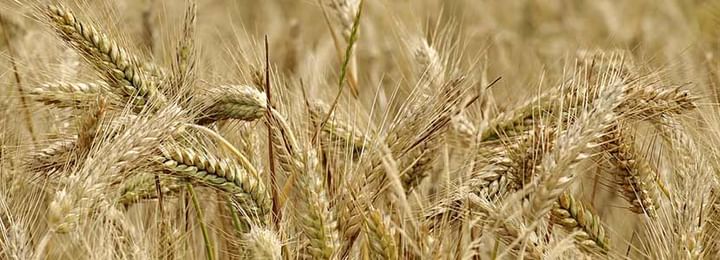Triticale Health Benefits, Uses And Its Side Effects
Last Updated: Sep 14, 2020
The health benefits of triticale seed are such that it helps to control diabetes, reduces digestion problems, helps in proper circulation of blood, optimizes body’s metabolic activity. Triticale grain reduces oxidative stress, promotes Bone Health, has antioxidant Nature, rich in minerals, reduces neural problems, increases cell production, have high folate content, helps in weight control.
Triticale
Triticale is a hybrid of wheat (Triticum) and rye (Secale) and was first bred in laboratories during the late 19th century in Scotland and Germany. Commercially available triticale is almost always a second-generation hybrid, i.e., a cross between two kinds of primary triticales.
Triticale combines the yield potential and grain quality of wheat with the disease and environmental tolerance (including soil conditions) of rye. Only recently has it been developed into a commercially viable crop.
Depending on the cultivar, triticale can more or less resemble either of its parents. It is grown mostly for forage or fodder, although some triticale-based foods can be purchased at health food stores and can be found in some breakfast cereals.
Nutritional Value of Triticale
Every 100 g of Triticale contains 336 calories of energy, 2.09 grams of total fat ( out of which saturated fatty acids is 0.366 g, monounsaturated fatty acids is 0.211 g and polyunsaturated fatty acids is 0.913 g), carbohydrate is 72 mg, protein is 13 mg, folate is 73.00 mcg, niacin is 1.430 mg, Pantothenic acid is 1.323 mg, Riboflavin is 0.134 mg.
Triticale nutritional content includes thiamine around 0.416 mg, Vitamin B6 is 0.138 mg, Vitamin E is 0.90 mg, Alpha Tocopherol is 0.90 mg, Calcium is 37.00 mg, Copper is 0.457 mg, Iron is 2.57 mg, Magnesium is 130.00 mg, Manganese is 3.210 mg, Phosphorus is 358.00 mg, Potassium is 332.00 mg, Sodium is 5.00 mg and Zinc is 3.45 mg.
Nutritional facts Per 100 Grams
Vitamins and Minerals
Health Benefits of Triticale
Triticale grain flour contains a good amount of protein and fiber content which is good for digestion. It holds Folate and magnesium which are good for various health issues such as red blood cell production and circulation, cardiovascular health. Antioxidative nature of Triticale grain helps in neural problems and good for diabetes patients. Mentioned below are the best health benefits of consuming triticale grain.
Triticale Helps to Control Diabetes
High fibre content in Triticale can help to keep the sugar levels in the blood in check. Triticale is also rich in the mineral manganese. Manganese is a mineral that assists a lot in converting the sugar level in the blood into energy and this is something which is highly required by a diabetic person.Therefore inclusion of Triticale as a part of diet by the patients of diabetes can be very much helpful.
Triticale Helps in Reducing Digestion Problems
In present day, proper digestion of food has become a dream for many of the people and this is because of the improper quality of food they intake. However if food isn’t digested well, it can lead to several other issues as well. Triticale is a crop which has high amount of fibre content in it that is highly essential for the proper digestion of food on the whole.
Triticale Helps in Proper Circulation of Blood
The circulatory system of the body plays an important role in the proper body building process and the organ maintenance as well and therefore it is highly essential for a person to maintain proper health conditions of the circulatory system and triticale has all the essential nutrients that can keep the health condition of the circulatory system in sound.
Add Triticale in Your Diet to Improve Metabolic Activity
Triticale is one such crop that is highly responsible for energy production through fibre and this can be helpful in optimizing the metabolism process in an individual and also has the potential to improve the cell development as well.
Triticale Helps in Reducing Oxidative Stress
Triticale Promotes Bone Health
Antioxidant Nature of Triticale Crop
Triticale crop is said to possess with some high amounts of antioxidant properties and these antioxidants are responsible for eliminating the free radicals on the whole within the body.
Triticale Rich in Minerals Content
Triticale is one such crop that is highly rich in minerals and it must not be forgotten that this particular crop can be helpful in maintaining the functioning of the entire body in a healthy state.
Triticale Reduces Neural Problems
There are high amounts of B complex vitamins or folates that are present in the triticale crop and all these ones can be regarded as the perfect remedies for handling neural tube defects quite effectively.
Triticale Helps in Increasing Cell Production
Along with fibre, triticale has a high content of protein than either wheat or rye. This means that cell production throughout the body can be increased, metabolic and enzymatic processes can be optimized, and general body functions can be more efficient.
Proteins are the building blocks of cells, as they can be broken down into their component amino acids and then re-structure into whatever materials our body needs in order to stay healthy. Along with protein, triticale also contains manganese, folic acid, and a number of other nutritional elements that are essential for cell production.
Triticale Offers High Folate Content
Consumption of triticale provides an individual with plenty of folate. In fact it contains around double the amount of folate found in wheat and around three times the amount compared with rye. Folate plays a number of essential roles in the body. It is vital for red blood cell production as well as the production of new cells throughout the body.
Folate is especially essential for women who are pregnant or trying to have a child and a deficiency is linked with birth abnormalities. It is also very important for growing children and teenagers who are going through a growth spurt.
Triticale Helps in Weight Management
Being so high in dietary fibre and low in fats, Triticale is a good option for people looking to shed a few pounds. Dietary fibre can help to feel fuller for longer and reduces the desire to snack throughout the day. In the long term, this can result in weight loss especially if a person incorporates the grain into his or her daily balanced diet and exercise regime.
Uses of Triticale
Being a good source of many vital nutrients, triticale is used as breakfast cereal. Flour from triticale is used in making breads and other bakery items. It is also used as forage and silage crops, as an animal feed, as a winter grazing crop.
Side-Effects & Allergies of Triticale
Triticale, like wheat and rye, contain high levels of gluten, so those who suffer from gluten intolerance or allergies, such as Celiac disease, should avoid triticale and try other non-gluten health cereals that won’t cause severe allergic reactions and gastrointestinal trouble.
Cultivation of Triticale
In 1875, for the first time triticale is mentioned in a report of the Scottish botanist A. Stephen Wilson who succeeded in pollinating wheat with rye pollen. He was lucky to raise just two plants which as a matter of fact were sterile so that further multiplication was not possible.
In 1883, the American Elbert S. Carmann successfully grew a real hybrid from a cross between wheat and rye. In 1888, the famous German plant breeder Wilhelm Rimpau managed to create a cross between wheat and rye. One of the four grains which he was able to harvest was fertile. The plant grown from it yielded 12 germinating kernels, and Rimpau was successful in multiplying them, but without economic success.
In 1921, in Russia, G. K. Meister in his breeding fields observed spontaneous pollinations of wheat plants with rye pollens from neighbouring plots. In 1973, in France, the technique to double the set of chromosomes by the use of colchicines was developed which came into use with many crops and which opened new possibilities in triticale breeding.
In 1968, in Hungary, the first promising triticale variety (BOKOLO) was released officially, but which finally did not yield as high as expected. In the same year Tadeusz Wolski started his own triticale breeding programme, and laid the foundation stone for the success of triticale in Europe and many other countries in the whole world.
References
- Zhu F. Triticale: Nutritional composition and food uses. Food chemistry. 2018 Feb 15;241:468-79. [Cited 26 June 2019]. Available from:
- Balode L, Kronberga A, Havensone G, Straumite E, Meija L. DIETARY VALUE OF TRITICALE WHOLEGRAINS [Internet] 2015. [Cited 26 June 2019]. Available from:
- Hosseinian FS, Mazza G. Triticale bran and straw: Potential new sources of phenolic acids, proanthocyanidins, and lignans. Journal of Functional Foods. 2009 Jan 1;1(1):57-64. [Cited 26 June 2019]. Available from:
Table of content
Ask a free question
Get FREE multiple opinions from Doctors



